Research Area A
Publications 2010
18-Feb-2011
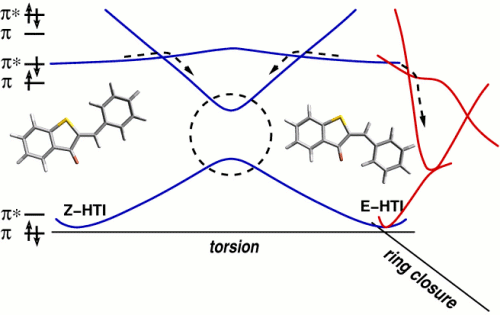
A combined experimental and theoretical investigation of photoinduced Z/E isomerizations is presented. Unsubstituted Hemithioindigo is selected as a representative minimal model to unravel the reaction mechanism in the presence of heteroatoms on an atomic level. Time-resolved spectroscopy reveals multiexponential reaction dynamics on the few picoseconds time ... READ MORE
30-Nov-2010
Heterocyclic aromatic amines produce bulky C8 guanine lesions in vivo, which interfere and disrupt DNA and RNA synthesis. These lesions are consequently strong replication blocks. In addition bulky adducts give rise to point and frameshift mutations. The translesion synthesis (TLS) DNA polymerase η is able to bypass slowly C8 bulky adduct lesions such as the widely ... READ MORE
09-Nov-2010
Frameshift mutations: Bulky adduct DNA lesions, such as the C8-acetylaminofluorene dG lesion (AAF-dG), induce frameshift mutations if they are placed in special gene sequences. With the help of synthetic AAF-dG lesions inserted into different repetitive frameshift-prone sequences, the molecular basis of the −I, −II, and −III frameshifting events was determined. ... READ MORE
25-Oct-2010
Mesoporous materials have a high potential for a number of different applications in Materials Science such as in molecular sieving, as masks for the formation of nanometre-sized metallic wires, as novel drug-delivery systems or as advanced host systems for catalysis. For many of these applications a thorough understanding of the interaction of guest molecules within ... READ MORE
22-Oct-2010
The natural products PreQ1, PreQ0, and archaeosine are deazaguanosine-derived natural products of immense biological importance. All three are critical components of tRNAs and, as such, are involved in decoding genetic information. We were able to consolidate and shorten the syntheses of all three compounds by using a novel Turbo-Grignard-based approach. The reported ... READ MORE
17-Sep-2010
5–Hydroxymethylcytosine (hmC) was recently detected as the sixth base in mammalian tissue at so far controversial levels. The function of the modified base is currently unknown, but it is certain that the base is generated from 5-methylcytosine (mC). This fuels the hypothesis that it represents an intermediate of an active demethylation process, which could involve ... READ MORE
02-Sep-2010
The presence of the methylated nucleobase 5MedC in CpG islands is a key factor that determines gene silencing. False methylation patterns are responsible for deteriorated cellular development and are a hallmark of many cancers. Today genes can be sequenced for the content of 5MedC only with the help of the bisulfite reagent, which is based exclusively on chemical ... READ MORE
02-Aug-2010
Redox-driven intracellular disulfide-cleavage is a promising strategy to achieve stimuli-responsive and controlled drug release. We synthesized colloidal mesoporous silica (CMS) nanoparticles with ATTO633-labeled cysteine linked to the inner particle core via disulfide-bridges and characterized their cysteine release behavior after internalization into HuH7 cells by ... READ MORE
25-Jul-2010
The natural products PreQ1, PreQ0, and archaeosine are deazaguanosine-derived natural products of immense biological importance. All three are critical components of tRNAs and, as such, are involved in decoding genetic information. We were able to consolidate and shorten the syntheses of all three compounds by using a novel Turbo-Grignard-based approach. The reported ... READ MORE
02-Jul-2010
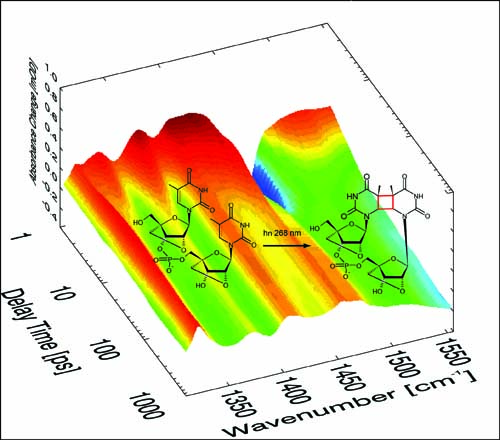
The cyclobutane pyrimidine dimer (CPD) formed between two adjacent thymine bases is the most abundant DNA photolesion induced by UV radiation. The quantum yield of this reaction is on the order of ~1% in DNA. This small quantum yield hampers the study of damage formation in naturally occurring DNA. Investigations with increased accuracy become possible for a ... READ MORE
22-Jun-2010
The prokaryotic ATP-dependent protease machineries such as ClpQY and ClpAP in the malaria parasite may represent potential drug targets. In the present study, we show that the orthologue of cyanobacterial ClpP protease in Plasmodium falciparum (PfClpP) is expressed in the asexual blood stages and possesses serine protease activity. The PfClpP was localized in the ... READ MORE
21-Jun-2010
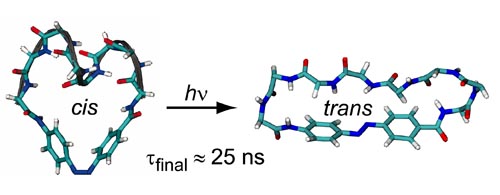
We study a monocyclic peptide called cAPB, whose conformations are light switchable due to the covalent integration of an azobenzene dye. Molecular dynamics (MD) simulations using the CHARMM22 force field and its CMAP extension serve us to sample the two distinct conformational ensembles of cAPB, which belong to the cis and trans isomers of the dye, at room ... READ MORE
10-Jun-2010
Letting off steam: A temperature-controlled valve system permits the targeted release of guest fluorescein molecules from the pores of colloidal mesoporous silica particles. The pore-opening temperature is dependent on the length of double-stranded DNA linkers. Avidin proteins that are joined to the DNA by a biotin modification act as the molecular valve at the exits ... READ MORE
10-Jun-2010
Finding DNA repair factors: A comparative study with DNA probes containing 8-oxodG and bearing different photo-crosslinking moieties found that a triethyleneglycol-trifluoromethyl-phenyldiazirine system was excellent for the labeling of DNA repair factors. This probe was used for the activity-based and selective labeling of different DNA repair factors in a human ... READ MORE
08-Jun-2010
Low-fidelity polymerases: Cells can copy genetic material even in the presence of DNA lesions. Here we show that this bypass process is also possible for the strongly helix disturbing cisplatin 1,3-GTG lesion. A key polymerase involved in the translesion synthesis (TLS) process is Pol η. The results have implication for the resistance problem associated with ... READ MORE
02-Jun-2010
A pretty couple: Two copper–salen metal–base pairs were incorporated into a DNA double helix in neighboring positions (see picture). The two paramagnetic CuII ions are antiferromagnetically coupled, and the exchange coupling constant is −2J=22.4 cm−1. The dipolar coupling constant yielded a Cu⋅⋅⋅Cu distance of 3.7 Å, which is comparable to the ... READ MORE
01-Jun-2010
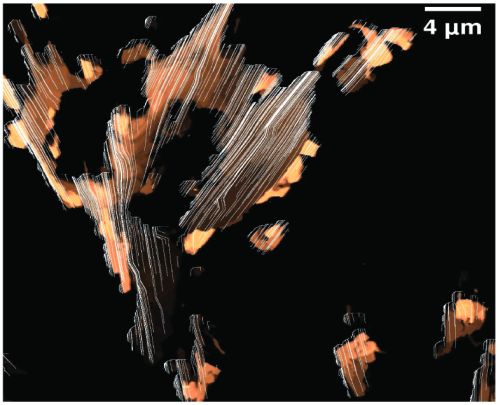
Self-assembled mesoporous structures with well-ordered nanoscale channels could be used in applications such as molecular separation, nano-optics, molecular electronics, nanomedicine and catalysis1, 2, 3, 4, 5, 6, 7. However, the domain sizes that can be created in such systems are limited by our lack of a detailed understanding of the relevant growth processes8, ... READ MORE
01-Jun-2010
We report on a one-step assembly route where supported lipid bilayers (SLB) are deposited on functionalized colloidal mesoporous silica (CMS) nanoparticles, resulting in a core−shell hybrid system (SLB@CMS). The supported membrane acts as an intact barrier against the escape of encapsulated dye molecules. These stable SLB@CMS particles loaded with the anticancer ... READ MORE
10-May-2010
We report the regioselective Cu-free click modification of styrene functionalized DNA with nitrile oxides. A series of modified oligodeoxynucleotides (nine base pairs) was prepared with increasing styrene density. 1,3-Dipolar cycloaddition with nitrile oxides allows the high density functionalization of the styrene modified DNA directly on the DNA solid support and ... READ MORE
09-Apr-2010
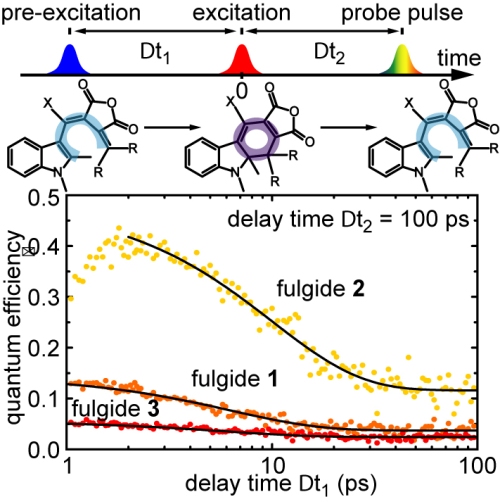
For three indolylfulgides the quantum efficiency of the ring-opening reaction upon pre-excitation is investigated in a multipulse experiment. The quantum efficiency grows by factor of up to 3.4, when the pre-excitation pulse immediately precedes the excitation process. The change in quantum efficiency after pre-excitation is discussed as a function of reaction ... READ MORE
23-Mar-2010
Flipped out: The cisplatin–(1,3-GTG) adduct, a strongly cytotoxic DNA lesion generated by the action of cisplatin therapeutics, is partially bypassed by Y-family DNA polymerase η. Crystal structure data on this DNA–protein complex explain the partial-bypass process. The central dT unit of the lesion is turned out and blocks the movement of the enzyme along the ... READ MORE
16-Mar-2010
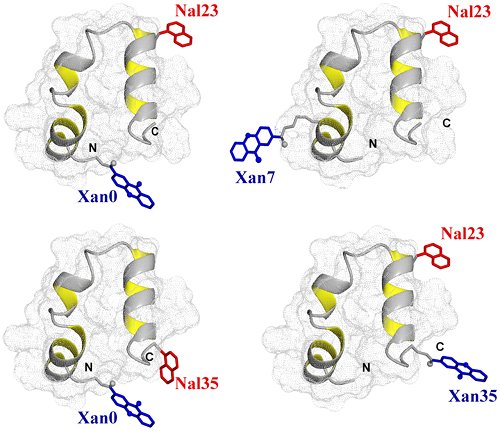
A reversible structural unlocking reaction, in which the close-packed van der Waals interactions break cooperatively, has been found for the villin headpiece subdomain (HP35) using triplet-triplet-energy transfer to monitor conformational fluctuations from equilibrium. Unlocking is associated with an unfavorable enthalpy change which is nearly compensated in free ... READ MORE
15-Mar-2010
A novel detection scheme for pump–repump–probe spectroscopy is presented, where the use of modulation and referencing allows to record the efficiency of a photochemical reaction as a function of the pump–repump delay in a single measurement. This new technique is applied to investigate the ring-opening reaction of an indolylfulgide after pre-excitation. Here ... READ MORE
18-Feb-2010

Repair of the Dewar valence isomers by (6-4) photolyases proceeds via an enzyme catalyzed ring-opening reaction of the Dewar lesion to the (6-4) photoproduct.
... READ MORE

